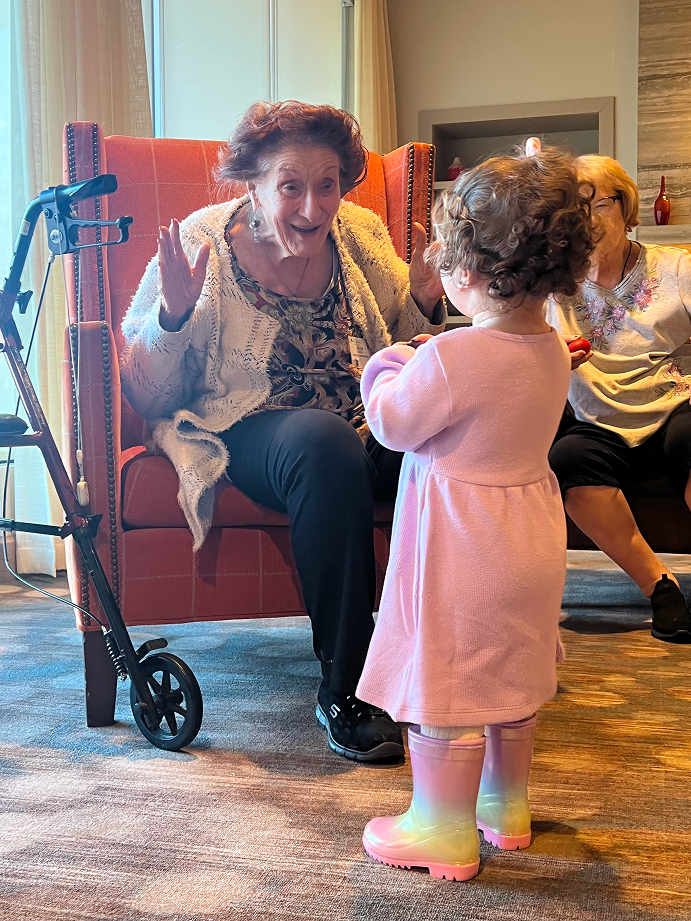We get better at what we practice. When we help our little ones notice music, they start to notice it on their own in everyday life. And they start noticing everything else too — rhythm, pattern, feeling, connection. This is how music teaches awareness.
The habit of noticing
One of the pillars of Bach & Boogie is what we call the habit of noticing. It’s not about talent — it’s about attention. To notice is to care. When a toddler turns toward a sound, when they light up at a familiar melody, they’re learning how to see beauty. When we help our little ones notice music, we’re helping them notice beauty — and that habit shapes who they become.
Children who practice noticing beauty and joy often grow into adults who seek it out — in people, in nature, in daily life. Psychologists call this an attentional bias toward the positive: the more we practice finding good, the more our brains expect to find it. Studies on gratitude and well-being have found that people who regularly focus on small moments of beauty and connection report higher happiness, stronger relationships, and even longer lifespans (Emmons & McCullough, 2003; Seligman et al., 2005).
In that way, helping a child notice music isn’t just musical education — it’s emotional education. It’s how we train the ear and the heart to look for what’s good, and to trust that joy is worth noticing.
The poet Mary Oliver once wrote, “To pay attention, this is our endless and proper work.” It’s true for all of us. Every time we pause to listen — to a violin, a breeze, a hum in the room — we’re strengthening the same muscle of awareness that helps us notice beauty, kindness, and love later in life.
Joy as reinforcement
Toddlers don’t learn because we tell them something matters; they learn because it feels good. Joy is the brain’s reward for attention. When noticing music feels delightful, the brain releases tiny doses of dopamine that say, “Do that again.” Over time, that joy becomes motivation to keep listening, keep noticing.
Neuroscientist Richard Davidson calls this kind of positive awareness “emotional plasticity” — the brain’s ability to reshape itself toward well-being. By pairing sound with warmth, laughter, and shared attention, we’re literally wiring joy to awareness.
How noticing builds connection
Music is never solitary — even when we listen alone, it carries traces of other people. A lullaby holds a parent’s voice. A rhythm echoes shared heartbeat and breath. When children learn to notice music, they’re also noticing belonging.
Research on musical synchrony shows that moving or singing together strengthens empathy and cooperation (Tarr, Launay & Dunbar, 2014). It’s why we end each Bach & Boogie class dancing together — not to “burn energy,” but to feel connection through rhythm.
Practicing the habit at home
Noticing music doesn’t require instruments or playlists. It just requires presence. A few gentle ways to begin:
- Pause and Listen: When you hear birds, a truck backing up, or a song in the grocery store, stop for five seconds and say, “Do you hear that?”
- Name the Feeling: “This song sounds cozy.” “This one feels like running!” It helps kids link sound to emotion and builds empathy.
- Revisit Favorites: Repeat the same song often. Familiarity lets them hear new layers they missed before.
- Invite Reflection: Ask what they liked best or what sound was funny. Let them lead your noticing.
- Ask Elders: “What songs did you love as a kid?” Music bridges generations in an instant.
When we slow down to notice music, we’re really teaching a deeper lesson: the world is worth paying attention to.
Simple ways to begin noticing music
Noticing is a practice — and practice loves rhythm. Here are a few small ways to start:
- Listen to Bach’s Partita No. 1 in B-flat major (BWV 825): It’s graceful and full of patterns that invite attention — little rises and falls, echoes and repeats. Let your child move, draw, or build quietly while it plays. Ask afterward, “What did you hear change?”
- Try one of the Bach & Boogie playlists: Pick a short stretch from Allegro, Largo, Vivace, or Boogie! and notice how your own energy shifts with each arc. (You can link your Spotify playlists or Calm Dial page here.)
- Do a sound scavenger hunt: Spend five minutes naming what you hear — birds, footsteps, fridge hum, your own heartbeat. Everything counts.
- Try a minute of shared silence: Sit together and listen for what’s left when the noise stops. That, too, is part of the music.
- Create an end-of-day song: Choose one gentle piece (a track from the Calm Dial works beautifully) and let it mark the moment when lights dim and the house softens.
Against overstimulation
Modern life rewards distraction. There’s always another sound, another scroll, another screen. Music — especially simple, real, shared music — invites us back to focus. It reminds us that meaning hides in the pauses. Writer Oliver Burkeman puts it beautifully: “Where your attention goes, your time goes.” Helping our kids notice is helping them live fully.
Closing thought
When we guide our children to notice the world’s small joys — a chord resolving, a kind gesture, a shared laugh — we’re helping them build internal maps toward connection and belonging. The practice of noticing music is really the practice of noticing life.
Want to practice it in community? Join a class →
